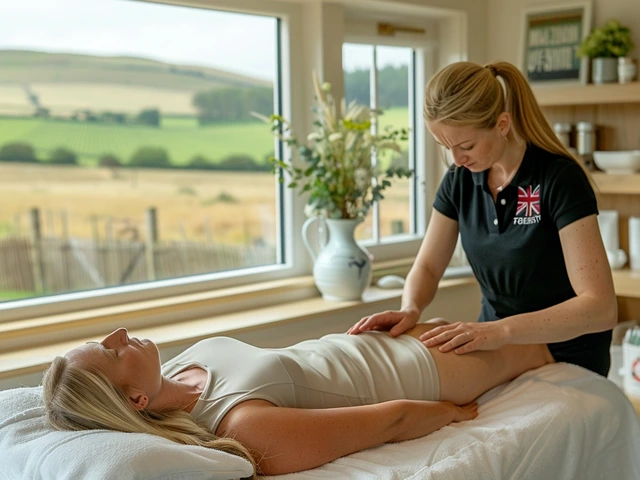Acupressure: The Go-To Stress and Anxiety Relief Tool

Feeling overwhelmed lately? You're not alone. Stress and anxiety have become part of everyday life for many of us. But what if there was a simple, natural way to help manage these feelings? Enter acupressure.
Acupressure is an ancient technique that involves applying pressure to specific points on the body to relieve tension and promote relaxation. It's like a massage, but with a targeted twist. You don't need any fancy tools or extensive training to give it a try, just your fingers and a bit of guidance.
Now, why bother with acupressure for stress and anxiety? The beauty of acupressure is that it's non-invasive and free from the side effects often associated with medication. Plus, you can practice it at home, at work, or anywhere you feel the weight of the world is getting too heavy.
Curious about how this actually works? Hang tight. Let's get into the basics of acupressure, how it supports mental well-being, and some specific points you can target to help put your mind at ease.
- What is Acupressure?
- How Acupressure Helps with Stress and Anxiety
- Key Acupressure Points to Target
- Tips for Practicing Acupressure at Home
What is Acupressure?
Acupressure might sound fancy, but it's a pretty straightforward concept with ancient roots. Picture acupuncture but without the needles, and you've got acupressure. This technique is based on the same principles as acupuncture, where energy, also known as "qi" or "chi," flows through channels in our bodies called meridians. The idea is to keep that energy flowing smoothly to maintain balance and health.
When this energy gets blocked or unbalanced, stress and other issues can crop up. Acupressure involves using fingers, thumbs, or even tools to apply pressure to specific points along these meridians. By doing this, it helps release blocked energy and brings the body back into harmony.
How Old Is Acupressure?
We're talking about a practice that's been around for over 4,000 years, tracing back to ancient China. It's part and parcel of Traditional Chinese Medicine (TCM) and has been a go-to natural remedy for various ailments, particularly stress, anxiety, and chronic pain.
Why Choose Acupressure?
So, why turn to acupressure instead of reaching for meds or other solutions? For one, it's non-invasive. Plus, you can do it yourself anytime, anywhere—a nifty little skill to have in your stress management toolkit. It's one of those methods blending tradition and modern needs so seamlessly.
Recognized Points with Functionality
Acupressure has specific points that target different issues. For instance:
- Pericardium 6 (P6): Commonly used for nausea relief but also known for calming the mind.
- Yintang: A favorite for relieving headaches and stress, often dubbed the "third eye" point.
- Kidney 1 (Bubbling Spring): Known for grounding and calming energy.
| Acupressure Point | Main Use |
|---|---|
| P6 | Nausea, calmness |
| Yintang | Headache, stress |
| Kidney 1 | Grounding energy |
These points are where you start if you're curious to see how a little pressure can bring more balance into your life. Next up, we'll explore how exactly acupressure helps with stress relief and anxiety management.
How Acupressure Helps with Stress and Anxiety
So, how does acupressure actually work its magic on stress and anxiety? The technique revolves around the idea that our body's energy, or Qi, flows through specific pathways called meridians. Stress and tension can mess with this flow, and acupressure helps bring things back into balance.
Improving Blood Flow and Relaxation
One key benefit of acupressure is its role in boosting circulation. When you apply pressure to certain points, you're nudging your body to increase blood flow. This improved circulation leads to increased oxygen distribution, which helps muscles relax and reduces the overall feeling of tension. This is a big win if you're feeling wound up due to stress.
The Troublesome Trio: Cortisol, Serotonin, and Endorphins
Here's the science bit: stress ramps up the production of cortisol, the well-known stress hormone. High levels of cortisol can leave you feeling anxious and edgy. Engaging in acupressure can help lower cortisol levels and simultaneously boost the body's feel-good chemicals like serotonin and endorphins. It's like giving your brain a little nudge to switch from panic mode to chill mode.
Find Your Calm: Key Pressure Points
Some spots on your body are especially effective for calming stress and anxiety. Let’s talk about a few:
- Union Valley (LI4): This spot between your thumb and index finger is famous for tension headaches and stress relief. Applying pressure here can promote relaxation quickly.
- Inner Gate (P6): Located three fingers down from your wrist in the middle of the inner side of your arm, pressing on this point can help reduce anxiety and enhance emotional stability.
- An Shen: This point is just behind your earlobe, and massaging it can help tackle insomnia related to stress.
Try giving these points a shot the next time you're feeling anxious or overwhelmed.
Quick Self-Help with Acupressure
If you're just starting out or looking for a quick fix, try these steps:
- Choose a comfortable position and take a deep breath.
- Apply firm pressure on one of the key points mentioned above.
- Massage in small circular motions, maintaining pressure for about one to two minutes.
- Switch to the other side and repeat if needed.
Easy, right? It's something you can do in a few minutes during a break at work or while watching TV. It's all about keeping stress in check without much fuss.

Key Acupressure Points to Target
Looking to reduce stress and ease anxiety? There are a few key acupressure points you can focus on to feel a bit more zen.
1. The Pericardium 6 (P6) or Neiguan Point
This spot is a crowd favorite for a reason. It's located about three finger-widths below your wrist on the inner forearm. Gently press this point to help calm your mind and reduce nausea—a handy trick for anxiety symptoms as well!
2. The Hegu Point (LI4)
This one's situated on the webbing between your thumb and index finger. The stress relief power here is strong, plus it's said to work wonders for tension headaches. Just apply firm pressure and breathe deeply.
3. Yintang (The Third Eye Point)
Situated right between the eyebrows, this point makes you feel like you're tapping into some ancient mystery. Gently but firmly pressing Yintang can help with relaxation and is great for relieving anxiety.
4. Shen Men (HT7)
Located on the little finger side of the inside of your wrist, the Shen Men point is where you'll find tranquility. Push this point when anxious thoughts begin to spiral.
For ease, here's a quick glance at where they've been used.
| Point Name | Location | Main Benefit |
|---|---|---|
| P6 | Inner forearm, three fingers below wrist | Calming, reduces nausea |
| LI4 | Webbing between thumb and index finger | Relieves tension |
| Yintang | Between eyebrows | Helps relaxation |
| HT7 | Inside of wrist on the little finger side | Soothes anxious thoughts |
It's about consistency. Regularly applying pressure to these spots might just become your go-to natural remedy for stress and anxiety. Easy enough to remember, right? Go ahead and give it a shot whenever the day feels a bit too much to bear.
Tips for Practicing Acupressure at Home
So, you're ready to dive into the world of acupressure? Awesome! The great thing about acupressure is that you can do it pretty much anywhere. No need for special equipment or a fancy setup. Let's talk about how you can effectively practice it at home.
Set the Scene
Before you start, find a quiet spot where you feel comfortable and won’t be disturbed. It's important to feel relaxed and focused. Dim the lights, put on some soothing music, whatever helps you get into the right mindset.
Learn the Basics
Get familiar with the acupressure points. There are tons of resources online with illustrations. Some key points for stress relief are called the Third Eye Point (between your eyebrows) and the Heavenly Pillar (at the base of your skull). These spots are known to help release tension.
Step-by-Step Guide
- Find a Point: Locate a specific acupressure point on your body. Use your fingertips or thumbs for pressure.
- Apply Pressure: Use firm pressure but it shouldn't hurt. A little discomfort is normal.
- Hold Steady: Maintain the pressure for about 1-2 minutes. Breathe deeply and slowly during this time.
- Repeat: You can repeat the process a few times a day as needed.
Additional Tips
- If you’re new to acupressure, start with just one or two points. No need to overload yourself.
- Stay hydrated. Drinking water helps flush out the toxins released with this technique.
- Consistency is key. Make it a part of your daily routine for the best results.
Precautions
Acupressure is generally safe, but there are some situations where you need to be cautious. If you're pregnant, have a condition like osteoporosis, or any disease that affects your bones, it's best to consult a healthcare professional first.
Trying out acupressure at home can be a great way to manage stress and anxiety. So go ahead, give those pressure points a try and see how you feel!





